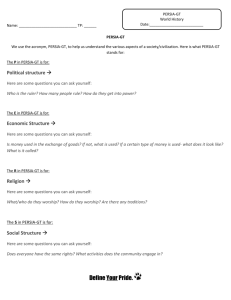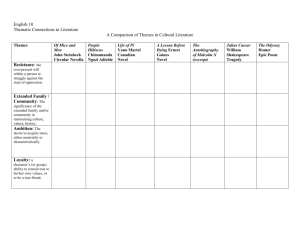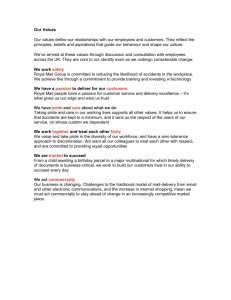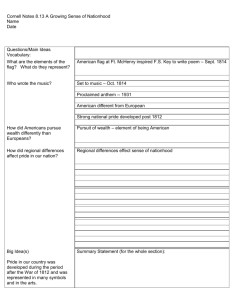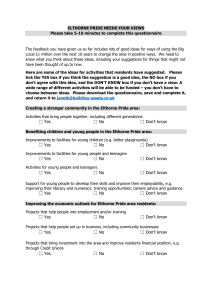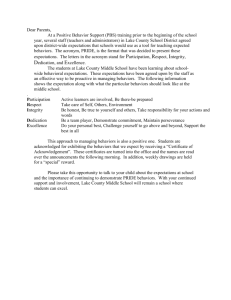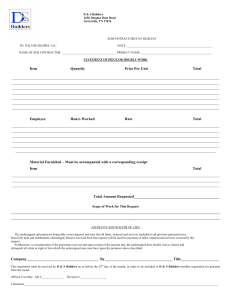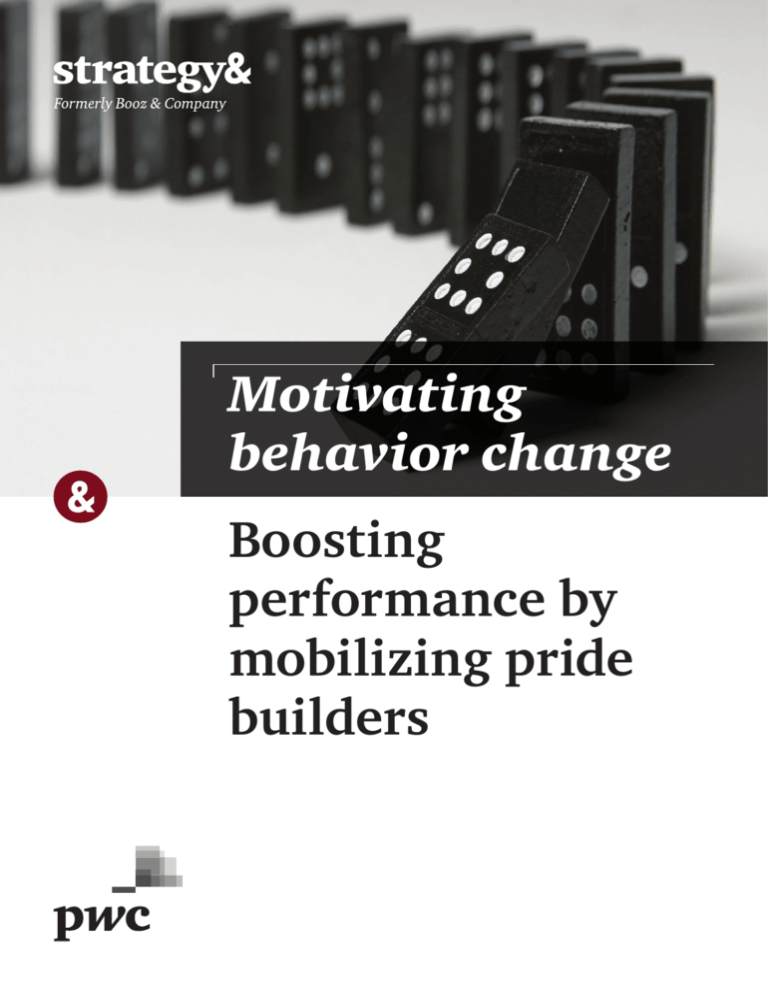
Motivating
behavior change
Boosting
performance by
mobilizing pride
builders
Contacts
About the authors
Chicago
Stockholm
Vinay Couto
Senior Partner
+1-312-578-4617
vinay.couto
@strategyand.pwc.com
Per-Ola Karlsson
Senior Partner
+46-8-50619049
per-ola.karlsson
@strategyand.pwc.com
New York
Sydney
Rutger von Post
Partner
+1-212-551-6090
rutger.vonpost
@strategyand.pwc.com
Varya Davidson
Partner
+61-2-9321-2820
varya.davidson
@strategyand.pwc.com
Jon Katzenbach
Senior Executive Advisor
+1-212-551-6115
jon.katzenbach
@strategyand.pwc.com
Zurich
San Francisco
Ilona Steffen
Principal
+41-43-268-2169
ilona.steffen
@strategyand.pwc.com
DeAnne Aguirre
Senior Partner
+1-415-627-3330
deanne.aguirre
@strategyand.pwc.com
Jon Katzenbach is a senior executive
advisor with Strategy& based in New
York. He formerly led the Katzenbach
Center, which develops practical new
approaches to leadership, culture, and
organizational performance. With more
than 45 years of consulting experience, he
is a recognized expert in organizational
performance, collaboration, corporate
governance, culture change, and employee
motivation. Prior to joining Strategy&, he
was a founder of Katzenbach Partners LLC.
He is the author of several books on team
performance, including the best-selling The
Wisdom of Teams, Teams at the Top, and The
Discipline of Teams.
Laird Post was formerly a principal with
Booz & Company.
Jonathan Gruber was formerly a senior
associate with Strategy&.
Aurelie Viriot was formerly a senior
associate with Booz & Company.
The authors thank Ilona Steffen, Rutger von
Post, and Adam Zalisk for their contribution
to this report.
This report was originally published by Booz & Company in 2011.
2
Strategy&
Executive summary
Achieving strategic goals and accelerating performance results
often requires that employees at multiple levels of the organization
change certain critical behaviors. Many companies do not succeed at
helping those employees change despite investing heavily in formal
initiatives such as financial incentives or training programs. The
problem is that they neglect an essential aspect of what motivates
employees — the emotional commitments that they must bring to the
organization and their jobs in order to do well and to exceed
expectations. By mobilizing those emotional commitments, companies
can accelerate the behavior changes required to elevate business
performance. “Pride Builders” — employees who instinctively know
how to connect what makes individuals “feel good” with their day-today activities and thereby instill in those people pride in the work they
do — can play a substantial role in mobilizing the kind of emotional
commitment that makes behavior change happen.
Pride Builders are often overlooked and underutilized, though their
potential is enormous. Organizations should follow a rigorous approach
to determine who the Pride Builders are and then build on their insights
and capabilities to influence behaviors. Pride Builders can be helpful
allies in spreading both motivational behaviors and performance
behaviors. In practice, an eight-step tactic we call a performance pilot is
often valuable in gaining insights and demon­strating impact.
Ultimately, companies can grow a robust community of Pride Builders
and develop the institutional capability to observe, capture, and spread
critical behavior changes throughout the organization.
Strategy&
3
Focus on the critical few
behaviors
The ever-increasing pace and magnitude of change in highly
competitive business environments has created an unprecedented
need for organizational agility. Driving behavior change rapidly
throughout the organization is more important than ever. By
behaviors, we mean the usual, repeated way in which employees
spend their time, make decisions, conduct relationships, handle
conflicts and truths, and perform their job. But behavior change is
hard to achieve. To illustrate that point: Think back to when you first
met your spouse. How many real behavior changes have you been able
to make (or motivate your spouse to make) since then? One? Two?
Organizations are no different. That’s why leaders have to pick their
battles carefully and identify those few critical behaviors essential to
achieving explicitly stated business objectives. Typically, addressing a
set of three to five key behaviors is doable. Behavior change is not
equally important for all employees. Consequently, it is imperative to
identify the employee groups whose behavior change will have the
most impact. In our experience, those groups are often leaders or
frontline employees who either interact with customers or shape the
company’s product and service offerings.
But what exactly are the appropriate critical behaviors to target?
Deciding which of the potential behavior changes you should focus on
is often tough. There are a number of dimensions to consider in
selecting the critical few:
Addressing
a set of three
to five key
behaviors is
doable.
• Business impact: Will the new behavior make a difference in
achieving the key priorities and objectives of the organization?
• Senior leadership support: Does management fully support this
behavior change?
• Momentum: Does the behavior change create motivation and
momentum for follow-up efforts?
• Measurability: Can we measure and track the targeted behavior
change?
4
Strategy&
• Ease of implementation: Can the targeted behavior change be
implemented with reasonable resources and appropriate support
from the organization?
• Timing: Will the targeted behavior change happen within the
required time frame?
In many cases, the critical behaviors that must change flow directly
from a reassessment of strategic and operating priorities or a new
strategy itself. For example, a telecommunications company adopted a
new customer-centric strategy, then identified the few critical
behavior changes required in its call centers for that new strategy to
come to life (see Exhibit 1).
Exhibit 1
Behavior change for a telecommunications call center
Current Behavior
New Behavior
Applying the New Behavior
Explain constraints and
limitations and offer standard
scripted alternatives
Take ownership of the customer’s
problem, focus on what you can do, and
don’t stop until the problem is solved
Instead of laying out in detail the terms and
rules behind overtime charges, recognize
the issue and come up with a creative and
satisfactory resolution
Give a detailed explanation
of services and internal
processes
Make explanations simple and relevant
to the customer; problem-solve with the
customer and modify organizational
processes to fit her needs
Ask the customer what she wants; concisely
offer solutions and do not burden the
customer with internal obstacles
Dive straight into addressing
the issue
Earn the customer’s confidence by listening,
clearing up confusion, and reassuring her
that you understand her concerns; build
rapport by learning something personal
about the customer’s situation
Find out why the customer’s minute usage
increased and, in the process, perhaps learn
that she now has to join a lot of conference
calls; tell her you will do your best to address
her situation
Focus on current promotions
and list available options in
response to the customer’s
request
Identify opportunities that match the
customer’s current situation
Proactively suggest a plan upgrade to avoid
future charges, but don’t “push” the promotion
for unlimited weekend calling, which this
customer doesn’t need
Address only the customer’s
stated request
Anticipate the customer’s future needs;
check in with her in a few weeks to see
how it’s going
Once the issue of past charges is resolved,
recognize that the customer makes a lot of
international calls and propose an additional
global calling program
Source: Strategy&
Strategy&
5
It’s one thing to determine the critical few behaviors, but quite
another to get your employees to adopt them. In most cases this
cannot be done by decree, however desirable that might be. If
behavior change is to become permanent and viable, it needs to
be motivated, not just mandated. It must be anchored in the
organizational culture, in the patterns of how people think, feel,
and believe.
To motivate employees in this way, appealing to both their rational
and emotional sides is necessary. Just look at the employees of such
extraordinary organizations as Southwest Airlines, Apple, or the U.S.
Marine Corps. Emotional commitment — not logical compliance
— is what determines employees’ exceptional service, innovation,
and dedication to the organization. Unprompted, these workers go the
extra mile for the good of their units and their organizations. For
instance, at Southwest Airlines, it is not uncommon for pilots to help
baggage handlers, and for flight attendants to interact with
passengers before they get on the plane. At Apple, employees
extensively network and communicate directly with customers and
other Apple devotees who care as much about the company and its
products as they do. And there are countless examples of
battlegrounds where Marines have brought out more members —
alive, wounded, and dead — than any other military unit operating
in the same theater, as well as more trivial evidence of emotional
commitment, such as the letters sent by readers to the Marine Corps
Gazette magazine in which they show in words their devotion to the
values of the Marine Corps.
Organizations
need to deploy
a well-balanced
combination
of formal and
informal levers.
To bring critical behaviors to life and achieve lasting change,
organizations need to deploy a well-balanced combination of formal
and informal levers. On the formal side, organizations can use
financial incentives, official communications, training programs,
performance management systems, or operating policies to help align
behaviors. On the informal side, peer-to-peer interactions through ad
hoc dialogue and collaboration, and open networks that connect
people and groups emotionally, are good approaches.
6
Strategy&
But in our experience, one informal approach is particularly powerful,
though largely overlooked: Tapping into the unique skills of the
accomplished “Pride Builders” in the organization, who know how to
connect the aspirations and drive of individuals to their day-to-day
work with the goal of ultimately accelerating behavior change and
improving business performance. Mobilizing Pride Builders in
conjunction with other formal and informal levers can greatly
accelerate change in an organization.
Strategy&
7
The power of Pride Builders
Instilling among employees pride in the work they do and in the
organization for which they do it is one of the most efficacious
ways to motivate employees to adopt the effective behaviors that
lead to greater commitment and enhanced performance. Nearly all
organizations have Pride Builders, although many companies are
not aware of them or don’t know how to capitalize on their potential
value. Simply put, Pride Builders are employees who excel at
motivating colleagues to achieve stellar results by building a strong
connection between individuals and their day-to-day work.
Pride Builders are not always the most charismatic or the highest
potential individuals in the organization. But their motivational
capabilities go well beyond what most good managers or “people
persons” do (see Exhibit 2, next page), and they can help influence
behaviors through informal interactions. For example, whereas most
good man­agers link an individual’s productivity and output to the
larger mission of the company, Pride Builders appeal to the emotional
side of individuals. Whereas good managers create momentum by
focusing on periodic results, Pride Builders target the behaviors
required for results; in other words, they get people to take pride in
the journey as well as in the destination. Whereas good managers help
individuals with the strongest potential achieve their best, Pride
Builders concentrate on the development of the entire team. In
essence, Pride Builders enable people to be the best they can be. This
translates into consistently delivering superior business results.
8
Strategy&
Exhibit 2
How Pride Builders differ
Good Manager
People Person
Pride Builder
-
Exceed business goals
-
Create meaningful relationships-
-
-
Make group’s work efficient
-
Ensure that all have a good time
Motivate and enable people to
achieve their personal best
-
Leverage own time
-
Meet business goals
-
Exceed business goals through
people’s performance, as well
as process execution
Core
Passion
-
Results
-
Relationships
-
Personal and individualized
meaning in own and staff’s work
Believes
Key
Motivators
Are
-
Promotion
-
Meaningful relationships
-
-
Compensation
-
Fun
Pride in individual work as well
as the company as a whole
-
Expanded personal growth
and responsibility
What Staff
Says About
Her/Him
-
“We get things done because
of him.”
-
“He’s fun to work with. I always
look forward to seeing him.”
-
“She’s the most motivating
manager I’ve worked for.”
-
“He’s a solid manager.”
-
-
“I don’t want to let her down.”
-
“I’m confident with him at
the helm.”
“I know he likes us to enjoy one
another.”
-
-
-
“He gives me the tools I need to
get the job done.”
“He realizes that people are
much more important than
numbers.”
“She’s a role model whose
passion and energy are
contagious.”
Primary
Goals
Source: Strategy&
Strategy&
9
Accelerating behavior change
Because Pride Builders excel at motivating others, one of the most
powerful ways an organization can use them is for accelerating behavior
change. It is important to recognize that there are two different kinds
of behaviors that Pride Builders can effectively influence: motivational
behaviors among their peers, and performance behaviors among their
subordinates.
Pride Builders exhibit motivational behaviors naturally. For example, they
are especially adept at maintaining rich personal connections and
knowing team members as individuals; they also know how to connect
individuals’ day-to-day work to an organization’s bigger strategic goals.
Some Pride Builder behaviors are common across most Pride Builders
(see Exhibit 3, next page); others are specific to the individual and
company environment. Accomplished Pride Builders and their peers have
mutual respect. As a result, leaders in the organization would be well
advised to solicit the help of Pride Builders in spreading their
motivational insights and methods by sharing them with their peers.
Performance behaviors differ from motivational behaviors. Performance
behaviors are those that pertain to the work itself and that the
organization needs to instill in order to address critical business
challenges. For example, in the midst of a turnaround, a manufacturing
company may need to emphasize behaviors in its operations and
maintenance teams that drive lower costs. Pride Builders can use their
motivational behaviors to accelerate the adoption of performance
behaviors — in this case, behaviors that drive lower costs.
Pride Builders
can use their
motivational
behaviors
to accelerate
the adoption of
performance
behaviors.
Beyond behavior change, Pride Builders can be helpful in a couple of
other ways:
• Providing insights from the front line: Pride Builders can effectively
advise senior leadership by piercing the “executive bubble,”
particularly during periods of transformation. They can help connect
the executive team to the realities in the trenches and provide unique
insights on communications, programs, and policies directed to the
10
Strategy&
Exhibit 3
What sets pride builders apart
Pride-Building
Behavior
What It Looks Like in Practice
Maintain rich
personal connections
and get to know team
members as individuals
-
Create sincere “human moments” of face-to-face contact
-
Hold social events to celebrate collective success and facilitate bonding
Connect individuals’
day-to-day work to
the bigger picture
-
Hold informal meetings to explain what enterprise-level decisions mean to the team and how
individuals’ work contributes to the goals of the company
-
Communicate strategic priorities in a personalized way that makes sense to the people doing the work
Make team members
stakeholders in
the work
-
Give everyone a voice in the problem-solving process in a collegial yet competitive atmosphere
-
Encourage and enable team members to think through problems themselves and build their
own list of solutions
Communicate clear,
actionable goals that
the team can relate to
-
Utilize a couple of simple metrics on which team members can directly act
-
Set clear expectations for all team members and give them autonomy to achieve them
Broaden the scope of
work and support
individuals’
development
-
Have regular one-on-one development and goal-setting conversations to identify stretch opportunities
-
Organize formal and informal training programs to support team members in taking on stretch opportunities
Recognize people
immediately for both
large and small
achievements
-
Celebrate small achievements for each person along the way to meeting a goal
-
Maintain a Wall of Fame featuring pictures of teammates and lists of their accomplishments
Provide and seek
constructive feedback
frequently
-
Have frequent formal or informal one-on-one meetings with team members in addition to annual
performance reviews
-
Be up-front about where each individual stands and carefully compile the evidence to back up
the assessment
Use an inclusive,
transparent
communication style
-
Deliver hard messages up front in team meetings and explain them in clear-cut terms
-
Gather the team to openly discuss trends in performance (positive or negative) and what drives them
Source: Strategy&
Strategy&
11
front line and middle management. They also can find creative ways
to work around roadblocks in formal systems and processes to enable
breakthrough performance.
• Institutionalizing a Pride Builder capability: As exemplars of the best
motivating behaviors, Pride Builders can provide insights into and be
role models for what all managers should do. Their methods and
means can be built into key talent processes such as recruitment,
training, performance assessment, and succession planning to help
reinforce pride-building skills in the organization. For example,
organizations can adjust the criteria used for employee performance
appraisal to encourage individuals to adopt the most powerful
motivating tactics observed in Pride Builders.
Because Pride Builders can be extremely versatile — and valuable —
organizations should carefully consider the precise ways that they can
help the business.
12
Strategy&
Identifying Pride Builders
Mobilizing Pride Builders to accelerate change and improve
performance begins with choosing the right group of respected
motivating employees to work with. The initial cohort of Pride Builders
should be individuals close to the front line who are widely recognized
as being able to both motivate their teams and achieve superior results.
Starting with a small group of high-quality, well-respected individuals
is important. Typically, the process of identifying Pride Builders
involves three steps:
Step 1: Clarify the criteria.
Articulating the characteristics that uniquely define Pride Builders in a
way that is tailored to the organization and in a language that resonates
with the organization’s culture is essential and often more difficult than
one would assume. However, once managers do understand these
criteria, they can typically identify potential Pride Builders quickly and
with relative accuracy. Determining which of the identified Pride
Builders to mobilize will depend on the way the organization is
planning to use them and on the behavior change priorities that must
be addressed. Relevant roles, levels, experience, or locations should be
defined clearly and carefully to ensure appropriate representation of
key populations — particularly when the performance issue being
targeted affects multiple functions or business units.
Ask a handful
of senior leaders
to identify
individuals who
fit the bill.
Step 2: Develop a short list of nominees.
With the criteria firmly in place, ask a handful of senior leaders —
for example, the head of a business unit or function — to identify
individuals in their organizations who fit the bill. Often they will be
frontline, customer-facing employees, but they don’t have to be.
Encourage these leaders to consult their direct reports, who may
also have ideas about potential Pride Builders. Nominators should
provide specific examples of how the team’s extraordinary level of
intrinsic motivation manifests itself and include quotes from team
members about the Pride Builders as well as actions the Pride
Builders have taken.
Strategy&
13
Step 3: Conduct targeted interviews and focus groups.
In-depth interviews with identified individuals are an excellent way to
confirm that they really are Pride Builders. These discussions should
bring out in more detail the behaviors that determine the unique,
tangible, even measurable differences in the way the Pride Builders’
teams operate. But even more revealing are the interviews with the
team members of potential Pride Builders. Whereas the Pride Builders
themselves are often unaware of what is “different” about them, people
on their teams recognize their unique talents and will use telling
phrases like “role model,” “contagious passion and energy,” or “best
supervisor I have ever worked with” to describe them. Group
discussions with direct reports or colleagues invariably deliver the
clearest picture of whether the individuals identified are real Pride
Builders and, if so, how they motivate the people they work with. In
some more structurally regimented settings, such as call centers or
distribution outlets, workplace observation may also be appropriate.
Generally, after Pride Builders are chosen, it is best not to be too public
about their names — although it is good not to be secretive about them
either. Mainly, the goal is to avoid any sense that certain people in the
organization are “especially gifted” and are thus in the “in crowd.”
In fact, it is important to cultivate the idea that many managers,
perhaps even most, have the potential to become Pride Builders, if
they are willing to learn and hone the skills that exemplify these
talented motivators.
14
It is important
to cultivate the
idea that many
managers,
perhaps even
most, have the
potential to
become Pride
Builders.
Strategy&
Pride Builder performance
pilots
Once the Pride Builders have been identified, the organization can
immediately begin leveraging their unique motivational skills to
address its most pressing challenges. In most situations, we
recommend starting with a performance pilot because it provides
quantitative validation that is very important in convincing a broad
base of potential Pride Builders. Pilots are also valuable because they
help the organization learn how to best deploy Pride Builders.
With this pilot approach, the organization selects a distinct area
(business unit, function, country, region) and deploys its Pride
Builders. At the same time, a “control group” is defined—a similar
unit where Pride Builders are not utilized. By measuring the results of
the pilot Pride Builder group and comparing them to the performance
of the control group, it is possible to demonstrate the impact of Pride
Builders almost immediately.
To develop a pilot, organizations should:
1. Define the challenge.
Identify a specific business challenge that is pivotal to achieving
performance goals and that requires broad-scale behavior changes in
key populations of the company.
2. Select one or two units for the pilot.
Initial pilots should be established in areas where success depends on
the performance of a large number of people with similar jobs, such as
call centers, shared-services organizations, or manufacturing teams,
and where it is possible to work directly with Pride Builders to
improve performance quickly—typically within two to five months.
The units chosen for the pilot should have a robust group of current
and potential Pride Builders to support the initiative. At this point, the
control unit should also be identified.
Strategy&
15
3. Design the pilot.
Select a small implementation team to lead the pilot launch and
eventually manage it. This group should be small enough to work
as a real team; that is, distinguished by shared leadership and mutual
accountability. In practice, the group may draw from additional
people as needed for specific pieces of work. The core team should
carefully select the Pride Builders it will work closely with, taking into
account the performance challenge at hand. Just because Pride
Builders display a certain set of motivating behaviors does not mean
they should necessarily all immediately be brought into the initiative.
Two or three accomplished Pride Builders along with a few potential
Pride Builders is often a good combination.
4. Determine the specific behaviors that need to change.
Initial sets of behaviors identified by senior leaders to be the focus of
the pilot can be refined through working sessions with both Pride
Builders and other high-performing individuals. Sometimes, the core
team is asked to determine the critical few behaviors and in the
process conducts interviews and prepares analyses, surveys, and
observational reports. Successful pilots typically earmark three to five
behaviors—but no more. Pride Builders tend to be particularly good at
identifying behaviors critical to the customer experience, but
additional input is often required to address other levers of
performance. The more direct the involvement of accomplished and
well-respected Pride Builders in helping to determine these behaviors,
the more credible they will be to others. Target behaviors should be
defined as specifically as possible and captured in a model clearly
establishing the current behaviors and how they must change.
Performance
metrics should
be specific,
compelling, and
directly related
to business
priorities.
5. Develop metrics and reminder mechanisms.
Measuring success is key to creating organizational momentum
around using Pride Builders to motivate behavior change and boost
performance. Moreover, the mere act of repeatedly measuring
performance and concomitant behavior shifts can act as a powerful
driver of change and a reminder of target behaviors. Having a clear set
of metrics for assessing both behavior change and resulting increases
in performance is a critical component of the pilot. Performance
metrics should be specific, compelling, and directly related to business
priorities. In addition, it is often valuable to track overall employee
engagement and pride in day-to-day work. Where available, trends in
employee culture survey results can be a valuable indicator.
16
Strategy&
6. Define specific approaches to mobilizing Pride Builders.
The specific ways in which Pride Builders are expected to help achieve
critical behavior changes should be clearly established. Typical
channels of engagement include working sessions with their teams,
peer-to-peer interactions, and feedback loops with management to
capture suggested improvements in how behaviors are defined or how
the pilot is conducted. The active guidance and engagement of senior
managers is also critical to building the pilot’s momentum.
7. Launch and monitor progress.
The pilot team must monitor progress closely and debrief participants
frequently, especially when the pilot is in its initial stages. It is often
necessary to continue refining the pilot behaviors, in some cases
significantly, after the effort is launched in order to meet various
demands and roadblocks that arise.
8. Measure impact and launch rollout.
As the pilot demonstrates a measurable impact in terms of both
behaviors and performance, the lessons learned about motivating
behavior change can be codified to drive similar improvements across
the organization. Knowledge about critical behaviors can be built
into key talent management processes and spread virally from the
initial set of Pride Builders to a broader range of frontline and
midline employees.
Strategy&
17
Creating a movement
From the start, the small group of Pride Builders is meant to grow virally
and expand to support broad-scale behavior changes. Organizations can
mobilize their initial set of Pride Builders to identify other Pride Builders
who can grow the group. Furthermore, Pride Builders can identify other
potential Pride Builders and spread their motivational skills—because
their skills are teachable.
For example, at a major telecom company, the team started out with
only 14 Pride Builders. Those 14 nominated 40 more, and the group
eventually grew to 150 Pride Builders identified by internal nominations
alone. This Pride Building team formed a community of practice to share
ideas, methods, and techniques; it eventually had more than 1,500
members.
A community of practice can be a powerful incubator for new Pride
Builders, because it is typically made up of both proven motivational
leaders and other managers aspiring to build their abilities in that area.
Specific activities of this group may include sharing pride-building
stories and insights with managers from across the organization,
updating best practices regularly, or creating community tools and
methods of reinforcement. If appropriately structured, the community
of practice can be a tremendous way to capitalize on peer-to-peer
interactions to spread pride-building abilities beyond formal training
and development programs. In addition, it can be an invaluable forum
for senior leadership; they can both mine insights from the motivational
leaders of the organization and recruit Pride Builders to support
strategic initiatives. It is often useful to consider the Pride Builder
community of practice to be an ongoing element of the organization
that can sustain pride-building capability over time.
18
Strategy&
Conclusion
Changes in critical behaviors required to meet performance goals can be
dramatically accelerated by capitalizing on a unique group of people who
can instill pride in day-to-day work among the individuals they work with
and motivate them to strive for their personal best. A systematic approach
to developing and building on the unique capabilities of motivational
managers can be a powerful “viral complement” to more traditional
programmatic approaches to driving change and increasing performance.
Establishing a robust pride-building capability has benefits for the
organization that stretch far beyond employee motivation. Organizations
that have embarked on a pride-building initiative often find that in the
process they have forged the capability, infrastructure, and leadership skills
needed to routinely achieve and scale the behavior changes required for
competitive advantage.
Strategy&
19
Strategy& is a global team
of practical strategists
committed to helping you
seize essential advantage.
We do that by working
alongside you to solve your
toughest problems and
helping you capture your
greatest opportunities.
These are complex and
high-stakes undertakings
— often game-changing
transformations. We bring
100 years of strategy
consulting experience
and the unrivaled industry
and functional capabilities
of the PwC network to the
task. Whether you’re
charting your corporate
strategy, transforming a
function or business unit, or
building critical capabilities,
we’ll help you create the
value you’re looking for
with speed, confidence,
and impact.
We are a member of the
PwC network of firms in
157 countries with more
than 184,000 people
committed to delivering
quality in assurance, tax,
and advisory services. Tell us
what matters to you and find
out more by visiting us at
strategyand.pwc.com.
This report was originally published by Booz & Company in 2011.
www.strategyand.pwc.com
© 2011 PwC. All rights reserved. PwC refers to the PwC network and/or one or more of its member firms, each of which is a separate legal entity. Please see www.pwc.com/structure for further
details. Disclaimer: This content is for general information purposes only, and should not be used as a substitute for consultation with professional advisors.


